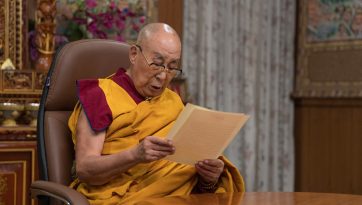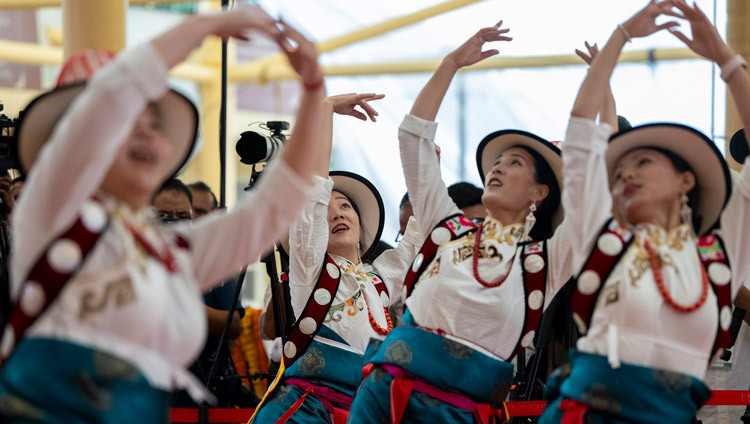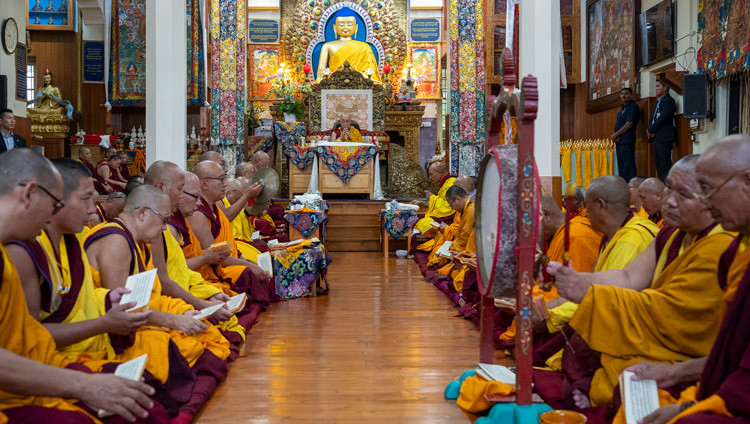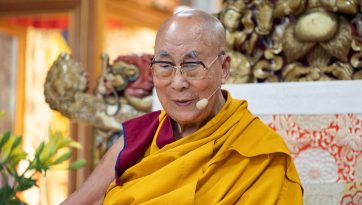Lamp for the Path to Enlightenment—First Day
July 13, 2021
Thekchen Chöling, Dharamsala, HP, India – After His Holiness the Dalai Lama had arrived this morning and taken his seat in the room at his residence from which he webcasts, Thupstan Chhewang, President of Ladakh Buddhist Association offered prostrations and gave a short introduction to the occasion.
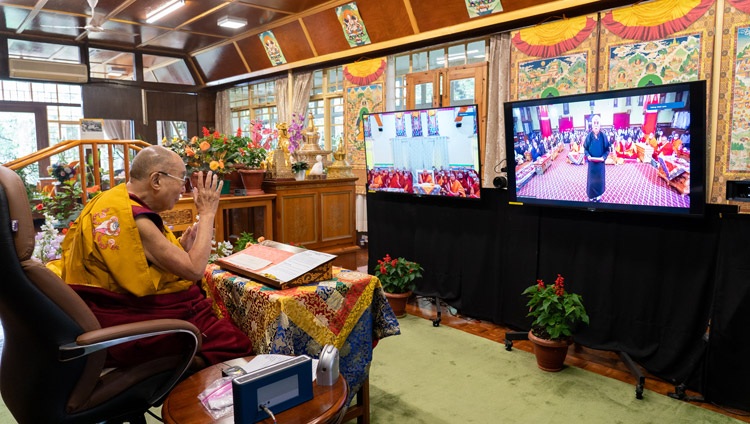
He declared that for two years, 2019 and 2020, His Holiness has been unable to visit Ladakh, and devotees, Buddhist and Non-buddhist, have missed him. Therefore, they requested His Holiness to visit this year, but again it has not been possible because of the widespread coronavirus pandemic and its associated restrictions.
Therefore, Thiksey Rinpoché, the Ladakh Buddhist Association and the Ladakh Gonpa Association requested His Holiness to give a discourse over the internet.
“So today,” His Holiness responded, “I’ve happily agreed to teach ‘Lamp for the Path to Enlightenment’ to the faithful laypeople and monastics of Ladakh. In Tibet we distinguished between the earlier and later disseminations of the Buddha’s teaching. At certain point, after Lang Darma’s opposition, Buddhism fell into decline. Consequently, a king in western Tibet was inspired to take steps to revive and preserve the teaching. He invited Atisha to visit Tibet from India and requested him to compose a short text for Tibetans. Atisha was pleased by the request and wrote this text at Thöling, as the first verse states, ‘Urged by the good disciple Jangchup Wö’.
“Eventually, ‘Lamp for the Path’ would influence the Sakyas’ ‘Path and Fruit’ tradition. It was also the source for Tsongkhapa’s ‘Stages of the Path to Enlightenment’ texts, as well as the inspiration for Gampopa’s ‘Jewel Ornament of Liberation’.
“Since tomorrow is the day on which we commemorate the Buddha’s first turning of the wheel of dharma, an occasion honoured by both the Pali and Sanskrit traditions, I will lead a ceremony for generating the awakening mind of bodhichitta.
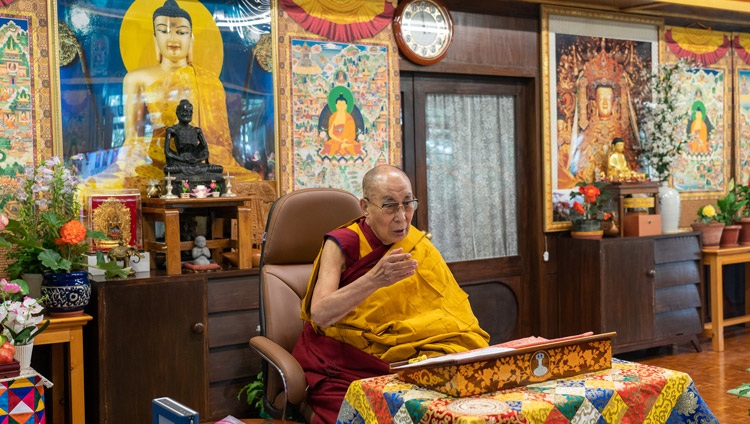
“I’ve received explanations of ‘Lamp for the Path’ from Tagdag Rinpoché, Ling Rinpoché, Trijang Rinpoché and Khunu Lama Rinpoché, Tenzin Gyaltsen. The Stages of the Path and Mind Training inform my daily practice. In addition, I practise Guhyasamaja, Chakrasamvara and Vajrabhairava, which belong to our tradition, as well as Hevajra and Vajrayogini that belong to the Sakyas. In this way I maintain the lineages of extensive conduct, the profound view of emptiness and the blessings of practice—all of which have their origin in India.
“The title of the text, ‘Bodhipathapradipam’—’Lamp for the Path to Enlightenment’, is given in Sanskrit to leave an imprint on students’ minds and as a mark of gratitude to India. Homage is paid to Manjushri, the embodiment of knowledge and wisdom. I was born in the vicinity of Kumbum Monastery and when I was a small child I was aware of people making prostrations and reciting Manjushri’s mantra, Om ara patsa nadhi. After coming to Lhasa, I followed the practice myself and I’m confident that it helps dispel the darkness of ignorance.”
His Holiness noted that the text is intended for beginners who will practise systematically. It mentions three kinds of persons, practitioners of least, middling and supreme capacity. Those who aspire to help others according to their disposition aspire to attain enlightenment and are said to be of supreme capacity. Atisha writes, ‘For those excellent living beings, who desire supreme enlightenment, I shall explain the perfect methods taught by the spiritual teachers.’
These methods include making the seven-part offering and taking refuge in the Three Jewels, the Buddha, Dharma and Sangha. Next, acolytes are encouraged to consider the sufferings of sentient beings and, since they want to free them from those, they are urged to arouse the resolve to attain enlightenment.
His Holiness remarked that Aryadeva wrote in his 400 Verses:
As the tactile sense [pervades] the body
Confusion is present in them all.
By overcoming confusion, you will also
Overcome all disturbing emotions.
All disturbing emotions arise in us because of our misconception that things exist inherently. However, when they are examined and analysed, no trace of inherent existence can be found, because they are dependent on other factors. Although afflictive emotions may be overcome, they leave imprints that act as obstructions to knowledge. Without removing them we cannot know everything as it is.
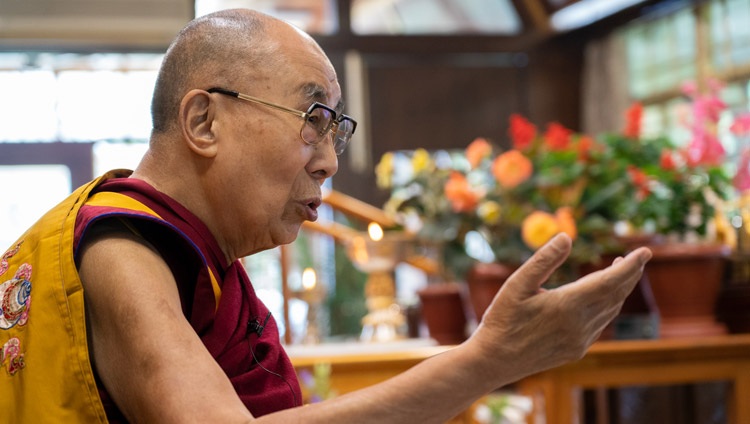
The qualities of developing an aspiration to enlightenment are fully explained in the ‘Array of Trunks Sutra’. And the merit of doing so is made clear in the ‘Sutra Requested by Viradatta’.
Any of the seven kinds of individual liberation vow are prerequisites for taking the bodhisattva vow. The text refers to taking the bodhisattva vow from a good and well qualified spiritual teacher. However, in case you try but cannot find such a spiritual teacher, you can invoke the presence of the protectors. His Holiness remarked that because that tradition had declined he restored it by taking the vow again before the statue of the Buddha in Bodhgaya.
Citing the experience of Manjushri as recorded in the ‘Ornament of Manjushri’s Buddha Land Sutra’, Atisha writes about maintaining pure conduct, giving up wrong-doing and cultivating the three forms of discipline so that they grow. He then discusses the need for higher perception, the ability to intuit the mental dispositions of other being in order to work for their good. He writes, ‘Those who want swiftly to complete the collections for full enlightenment, will accomplish higher perception through effort, not through laziness’.
His Holiness stopped there for the day saying that he will resume and complete reading the text tomorrow from where it explains the attainment of calm abiding. He invited questions, all of which were posed by young Ladakhi students.
The first concerned whether it is necessary to believe in past and future lives to engage in the seven-fold cause and effect approach to cultivating the awakening mind. His Holiness agreed that the first of the seven steps involves recollecting the kindness of other sentient beings when they have been our mothers. He suggested that one ploy would be to examine the reason and logic supporting the notion of past and future lives.
An alternative would be to engage in the powerful method Shantideva advocates of equalizing and exchanging self with others. His Holiness remarked, “The more you help others the calmer your mind will be. You will be able to overcome misdeeds committed in relation to others. Familiarizing your mind with kindness and compassion yields peace of mind, which makes you happier and even improves your physical health.”
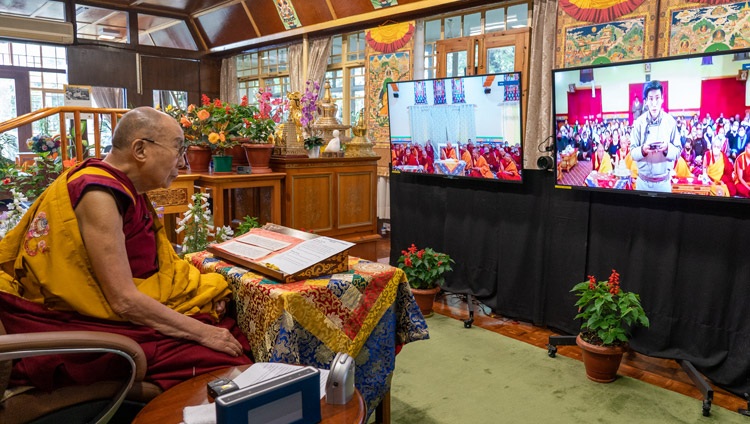
Asked why sutra is presented before tantra, His Holiness replied that it is a realistic order. To begin with you develop the awakening mind and an understanding of emptiness by following the sutra path. Without them it is not be possible to practise tantra. The Buddha taught the four noble truths first. Later, he expounded the perfection of wisdom and in the third round of his teachings he explained the subjective mind of clear light on the basis of which he led disciples into tantra.
Following his enlightenment, the Buddha is reported as having thought:
Profound and peaceful, free from complexity, uncompounded luminosity—
I have found a nectar-like Dharma.
Yet if I were to teach it, no-one would understand,
So, I shall remain silent here in the forest.
‘Uncompounded luminosity’ can be understood as referring to the subjective mind of clear light. His Holiness added that after the 80 different conceptual states of mind have dissolved, at the time of death, there are the three stages of whitish appearance, reddish increase and black near attainment, after which the mind of clear light manifests. The first line of the verse above can be understood to indicate a systematic path to enlightenment.
His Holiness observed that followers of Tibetan Buddhism participate in a tradition that encompasses the entire teaching of the Buddha. At the time of King Songtsen Gampo Chinese Buddhists came to Tibet, but they did not engage in analysis. Later, King Trisong Detsen felt it was important to use human intelligence to the full and so invited the erudite philosopher and logician Shantarakshita to establish Buddhism in Tibet. He demonstrated the importance of logic and epistemology, as well as the Middle Way (Madhyamaka) view and encouraged study, reflection and meditation.
Another questioner asked why one text states, ‘I shall not be eager to reach enlightenment in the quickest way, but shall stay behind till the very end for the sake of a single being’, while another says, ‘I shall attain the state of Buddhahood as quickly as possible for the sake of all sentient beings’. His Holiness replied that it is the interest of others that is paramount. The intention is to attain enlightenment for the sake of other sentient beings not for ourselves. He went on to say that clairvoyance, or higher perception, is crucial to being able to judge others’ character and disposition in order to help them to the full.
For example, there are those who misapprehend the meaning of emptiness and interpret it as nothingness. Unfamiliar with the ground, path and result, when they hear about emptiness, that form is empty and emptiness is form, they conclude that it is nihilistic. The Buddha didn’t teach about emptiness immediately, but in his presentation of the four noble truths he declared that suffering must be known and its origin overcome. He then elaborated that although suffering must be known, there is nothing to be known.
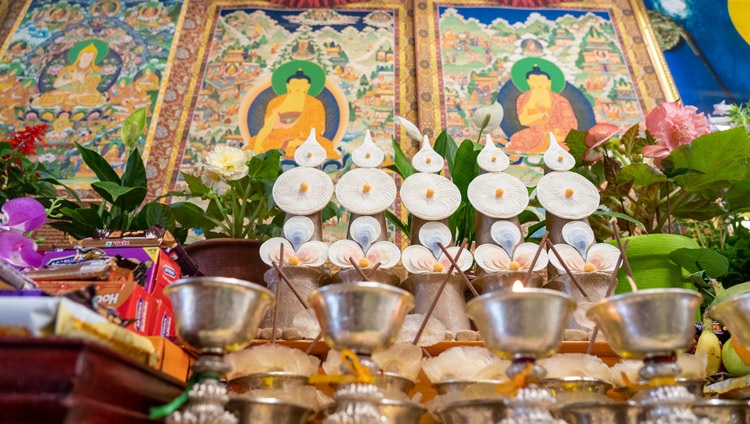
He did not teach emptiness explicitly when he introduced the four noble truths because as he said, ‘if I were to teach it, no-one would understand’. However, later, when disciples were more mature and prepared to accept it, he laid out emptiness during the perfection of wisdom teachings on Vulture’s Peak. Subsequently, at Vaishali, in the ‘Tathagatagarbha Sutra’ he revealed Buddha-nature, the mind of clear light.
His Holiness declined to say whether all the good qualities of the world’s various religious traditions could be merged into one spiritual tradition. He acknowledged that some traditions believe in a creator god while others do not. However, despite these philosophical differences, they all teach the importance of kindness. Not only do they have warm-heartedness, love and compassion in common, they all teach their followers not to harm others, but to help them. As far as Buddhism is concerned, compassion is the wish to free others from suffering.
There was some discussion of how the vow of individual liberation mentioned in verse 20 of the text is the basis for taking the bodhisattva vow. His Holiness noted that the individual liberation vow is received from a master, while the bodhisattva vow can be taken before a visualized assembly of Buddhas and bodhisattvas.
As the session came to an end, a verse of dedication was chanted in Ladakh. His Holiness smiled and told his virtual audience, “See you tomorrow”.
SOURCE: dalailama.com

